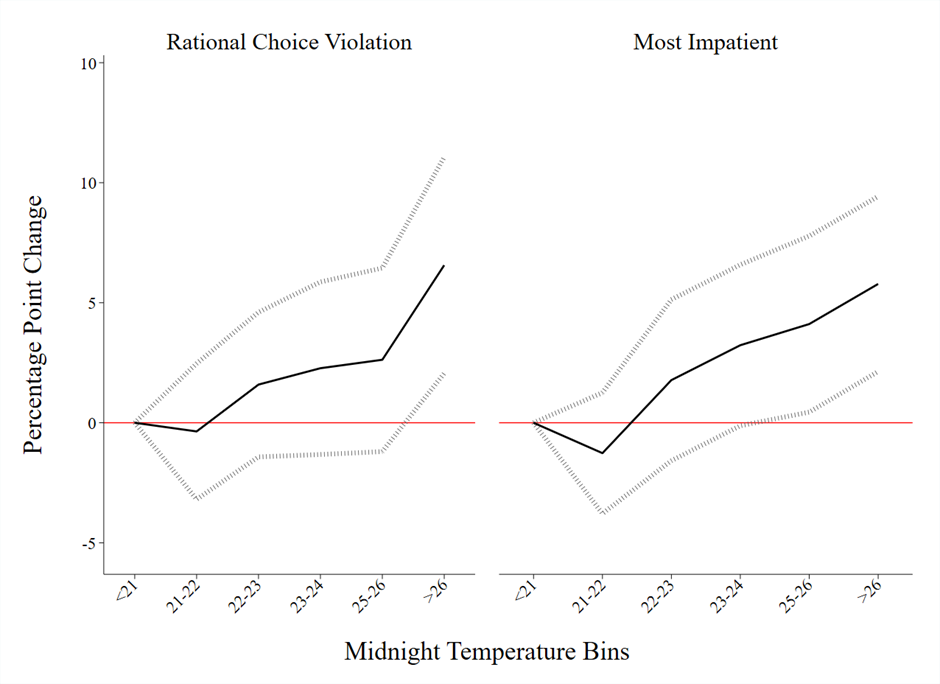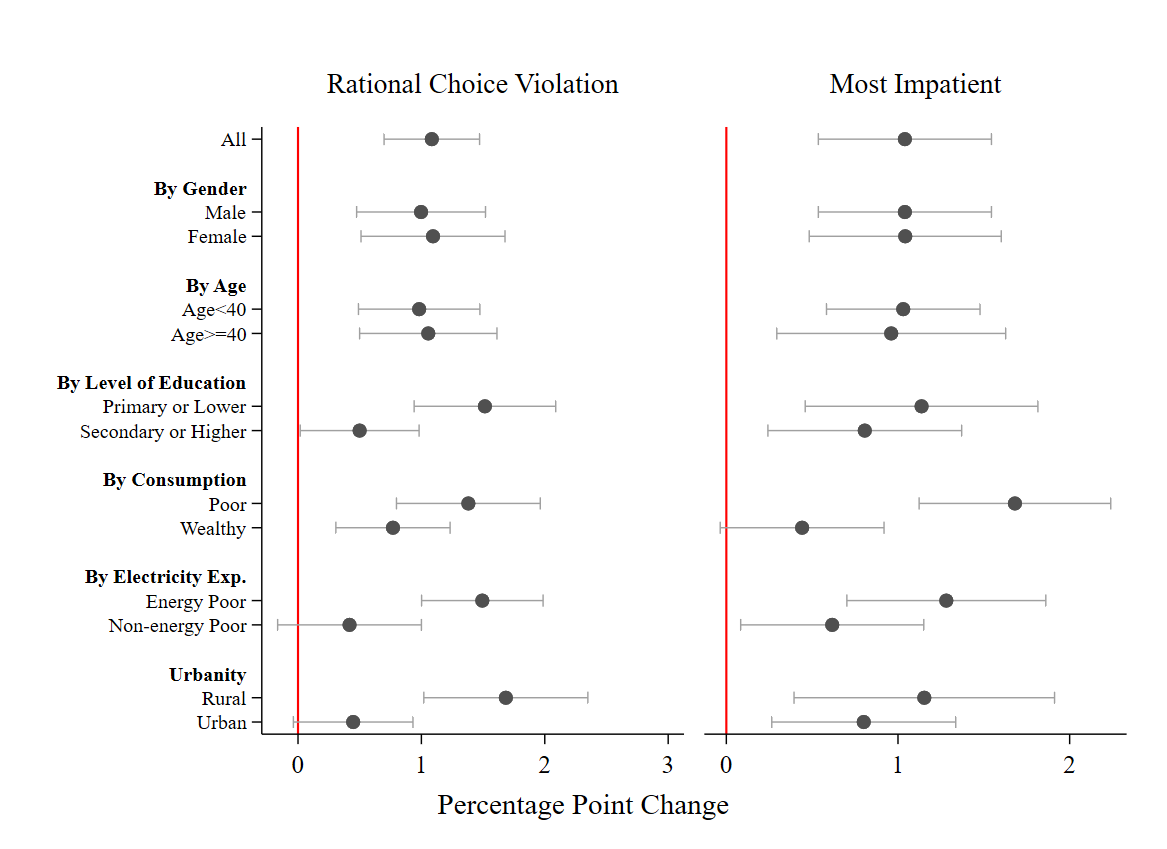
Research in Indonesia shows that elevated night-time temperatures disturb sleep, hinder cognitive performance and increase impatience and irrational behaviour. These effects disproportionately impact vulnerable populations.
As the planet continues to warm due to climate change, heat wave events are becoming more common, subjecting millions – particularly in low- and middle-income countries – to extreme temperatures more frequently. This isn’t just a physical health concern; extreme heat can have subtle yet powerful effects on how people think, reason, and make decisions. Economic decision-making is particularly important because it affects individuals' financial wellbeing, resource allocation, and future planning. Decisions related to spending, saving, investing, and risk-taking can have lasting impacts. Understanding how short-term temperature shocks influence these decisions is therefore crucial.
Our study used data from the Indonesia Family Life Survey (IFLS) to explore whether exposure to short-term temperature fluctuations affects economic choices among Indonesians (Escobar et al. 2024). We focused on individuals living in similar climatic zones but experiencing different temperatures during and in the day prior to their interviews, providing the quasi-random variation needed to identify causal relationships between heat exposure and sleep, cognition, and economic outcomes.
Indonesia serves as an important case study due to its frequent extreme temperatures, allowing insight into the impacts of heat. Moreover, findings from Indonesia provide lessons that are relevant to other tropical low- and middle-income countries, where high temperatures and humidity are similarly common.
Hot nights disrupt sleep
Night-time heat has been proven to be important due to its impact on sleep, a key potential mechanism linking temperature to impaired decision-making. Scientific studies have long demonstrated the sensitivity of sleep to changes in ambient temperature. Laboratory studies provide a controlled view of how even modest temperature shifts can disrupt sleep patterns. For instance, it has been shown that experimentally reducing temperature by just 2°C can significantly improve slow-wave sleep, which is essential for restorative rest (Togo et al. 2007). Conversely, higher temperatures have been shown to reduce sleep efficiency and increase night-time awakenings, leading to poorer overall sleep quality (Fan et al. 2022).
Our data mirrored these laboratory findings in a real-world setting. We observed that higher midnight temperatures led to a significant increase in sleep disturbances among respondents, as measured by a validated sleep disturbance scale. For example, if most nights in the past week were hot, the probability of reporting disturbed sleep increased by around 11%.
Less sleep impairs cognitive function
The relationship between high night-time heat and sleep is concerning given that sleep quality is an important determinant of cognitive functioning (Van Dongen et al. 2003, Vartanian et al. 2014). Poor sleep can reduce attention, impair cognitive capacity, and undermine problem-solving skills, leading to more frequent decision-making errors and suboptimal behaviours (Drummond et al. 1999).
We explored how heat-induced disruptions to sleep influenced cognition by using tests administered to respondents of the Indonesia Family Life Survey (IFLS). These tests measured various cognitive domains, including mathematical skills, fluid intelligence, and memory recall. Our study estimated the impact of elevated midnight temperatures on these cognitive outcomes, with particular emphasis on mathematics, a skill closely tied to rational economic decision-making. For example, mathematical ability influences an individual’s capacity to perform complex intertemporal calculations and weigh trade-offs.
Our findings revealed that a 1°C increase in night-time temperature was associated with a measurable decline in math test scores, ranging from a 1.1% to 3.2% reduction of a standard deviation, depending on the respondent's age and survey wave. These findings highlighted how exposure to high night-time temperatures impairs cognition, potentially undermining individuals’ decision-making abilities and rationality.
High night-time temperatures make individuals more irrational and impatient
The cognitive deficits brought about by heat-induced sleep disturbances have implications for economic behaviours. Our study demonstrated this by exploring how night-time temperatures influenced rational choice violations, intertemporal preferences, and risk aversion. Our findings revealed that a 1°C increase in midnight temperature was associated with a 1.1 percentage point rise in rational choice violations. This measure was captured through a hypothetical lottery game where respondents chose between a certain payoff or a gamble. Respondents exposed to higher night-time temperatures were more likely to choose suboptimal or ‘irrational’ options, suggesting that impaired cognitive function may reduce their ability to make optimal decisions.
Similarly, we observed that high night-time temperatures increased impatience, as reflected by time preference tasks. Respondents were more likely to prefer smaller immediate rewards over larger delayed ones following exposure to higher temperatures. This increase in impatience suggests a diminished capacity for delayed gratification and self-control, key components of intertemporal decision-making. In practical terms, such behaviour could lead to lower savings rates, suboptimal investment choices or other decisions that erode long-term financial stability.
Figure 1

Interestingly, despite the clear impacts on rationality and impatience, our analysis did not find a significant effect of heat exposure on risk preferences. This distinction highlights the complexity of how heat affects different aspects of economic behaviour.
The disproportionate impacts of high temperatures on vulnerable populations
The negative effects of high night-time temperatures were not experienced equally across our sample. Economically disadvantaged and rural households faced the greatest burden. Specifically, our analysis revealed that more disadvantaged respondents – measured by educational attainment, electricity consumption and overall expenditures – experienced significantly greater likelihood of sleep disturbances, rational choice violations, and impatience, compared to other respondents.
Figure 2

These disparities can be attributed to several key factors. First, economically disadvantaged and rural households often lack access to cooling resources, such as air conditioning, which can provide critical relief during hot nights (Pavanello et al. 2021). Second, these groups frequently experience intermittent or unreliable electricity, limiting their ability to use even basic cooling methods like fans. Third, poorer housing structures with less insulation and fewer temperature-regulating features often retain heat, exacerbating exposure to high indoor temperatures (Ramsay et al. 2021, Scott et al. 2017). Finally, limited financial resources restrict their ability to invest in adaptive measures, such as improved ventilation or energy-efficient cooling solutions, as well as their ability to bear the high electricity bills associated with air-conditioning ownership.
Our findings emphasise that the challenges posed by high night-time temperatures extend beyond individual behaviours to broader structural inequalities. By disproportionately affecting those with limited means to protect themselves, extreme heat exacerbates existing socioeconomic disparities. Policy interventions aimed at improving access to affordable cooling technologies, strengthening infrastructure, and supporting low-income communities are crucial. Addressing these vulnerabilities will not only enhance individual wellbeing but also contribute to greater economic resilience in the face of rising global temperatures.
References
Drummond, S P A, G G Brown, J L Stricker, R B Buxton, E C Wong, and J C Gillin (1999), “Sleep deprivation-induced reduction in cortical functional response to serial subtraction,” NeuroReport, 10(18).
Escobar Carias, M S, D W Johnston, R Knott, and R Sweeney (2024), “Temperature's toll on decision-making,” The Economic Journal, 134(663): 2746–2771. https://doi.org/10.1093/ej/ueae036.
Fan, X, H Shao, M Sakamoto, K Kuga, L Lan, D P Wyon, K Ito, M P Bivolarova, C Liao, and P Wargocki (2022), “The effects of ventilation and temperature on sleep quality and next-day work performance: Pilot measurements in a climate chamber,” Building and Environment, 209.
Pavanello, F, E De Cian, M Davide, M Mistry, T Cruz, P Bezerra, D Jagu, S Renner, R Schaeffer, and A F P Lucena (2021), “Air-conditioning and the adaptation cooling deficit in emerging economies,” Nature Communications, 12(1): 6460.
Ramsay, E E, et al. (2021), “Chronic heat stress in tropical urban informal settlements,” iScience, pp. 1–12.
Scott, A A, et al. (2017), “Temperature and heat in informal settlements in Nairobi,” PLoS ONE, 12(11): e0187300.
Togo, F, S Aizawa, J I Arai, S Yoshikawa, T Ishiwata, R J Shephard, and Y Aoyagi (2007), “Influence on human sleep patterns of lowering and delaying the minimum core body temperature by slow changes in the thermal environment,” Sleep, 30(6).
Van Dongen, H P A, G Maislin, J M Mullington, and D F Dinges (2003), “The cumulative cost of additional wakefulness: Dose-response effects on neurobehavioral functions and sleep physiology from chronic sleep restriction and total sleep deprivation,” Sleep, 26(2).
Vartanian, O, F Bouak, J L Caldwell, B Cheung, G Cupchik, M E Jobidon, Q Lam, A Nakashima, M Paul, H Peng, P J Silvia, and I Smith (2014), “The effects of a single night of sleep deprivation on fluency and prefrontal cortex function during divergent thinking,” Frontiers in Human Neuroscience, 8(1): APR.




